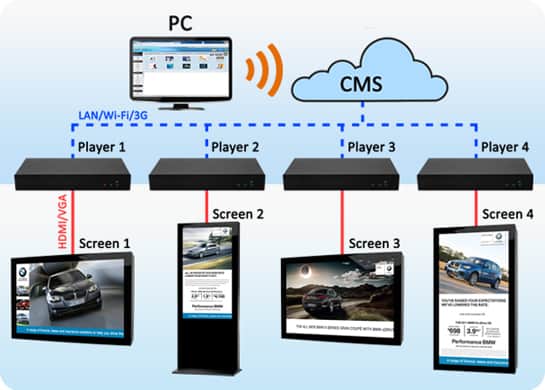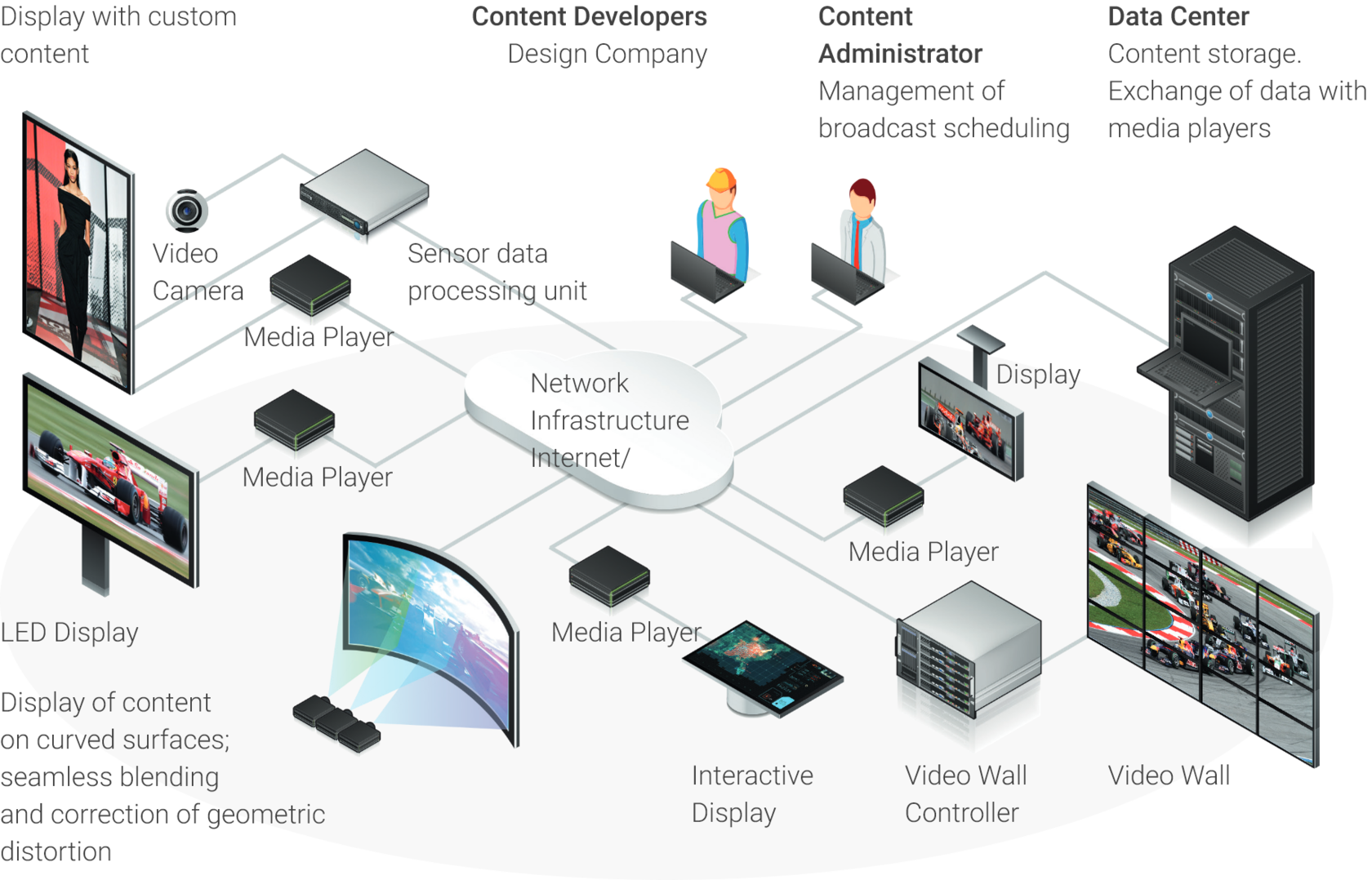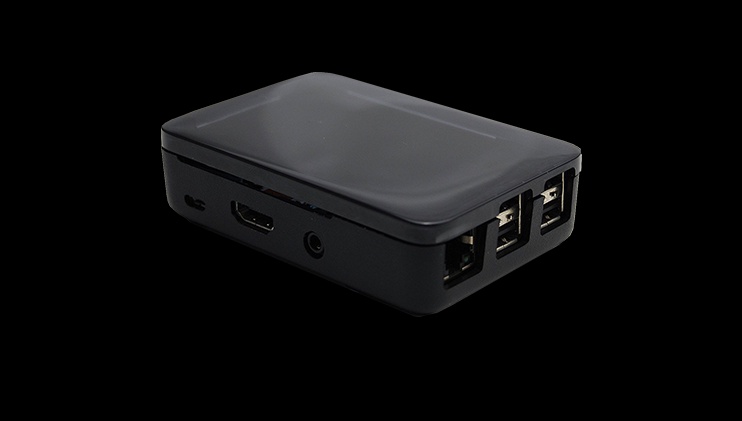
Digital Signage Player
Digital Signage Player In today's fast-paced digital era, businesses, and organizations are constantly seeking innovative ways to captivate their audiences and convey their messages effectively. Digital signage has emerged as a powerful tool in this endeavor, enabling dynamic and engaging content delivery across various industries. At the heart of any successful digital signage network lies the digital signage player – a key component that drives the seamless playback of captivating visuals. In this article, we delve into the world of digital signage players, exploring their functionalities, benefits, and their impact on transforming communication and engagement.
Understanding Digital Signage Players:
Digital Signage Player acts as the engine behind captivating content delivery. They are compact, purpose-built devices that receive, store, and playback multimedia content on digital displays. These players are designed to handle a range of media formats, ensuring compatibility with different types of content such as images, videos, and interactive applications. Equipped with advanced hardware and software capabilities, they seamlessly synchronize content playback across multiple screens, creating an immersive and impactful visual experience.
Key Features and Functionalities:
Digital signage players offer a wide array of features and functionalities that enhance the overall effectiveness of the digital signage network. Some of the key features include:
a. Content Management: Players enable centralized content management, allowing businesses to update and schedule content remotely. This ensures timely and relevant information delivery to the target audience.
b. Scalability: Digital signage players can scale to accommodate networks of varying sizes, from a single display to an extensive network spread across multiple locations. They offer flexibility and adaptability to meet the evolving needs of businesses.
c. Connectivity Options: Players support various connectivity options, including Wi-Fi, Ethernet, and cellular networks, enabling easy content distribution and management. They can connect to cloud-based platforms, ensuring real-time updates and monitoring.
d. Interactive Capabilities: Some advanced digital signage players support interactivity through touchscreens and motion sensors. This enables businesses to engage customers with interactive content and gather valuable data for personalized experiences.
Benefits of Digital Signage Players:
Implementing digital signage players in a business environment yields several advantages:
a. Enhanced Engagement: Digital signage players deliver visually appealing and dynamic content, attracting attention and engaging viewers. This leads to increased brand awareness, improved customer experiences, and higher audience engagement.
b. Cost-effectiveness: Compared to traditional printed signage, digital signage players offer cost savings in the long run. With digital displays, businesses can update content instantly, eliminating printing and distribution costs associated with static signage.
c. Timely Information Delivery: Digital signage players enable real-time content updates and scheduling, ensuring timely and relevant information reaches the intended audience. This is particularly beneficial in dynamic environments like retail stores, airports, and hotels.
d. Analytics and Insights: Advanced digital signage players provide analytics and reporting capabilities, allowing businesses to measure the effectiveness of their content and campaigns. These insights help optimize messaging and tailor content to specific target audiences.
Industry Applications:
Digital signage players find applications across various industries:
a. Retail: Players help create immersive shopping experiences, showcasing product information, promotions, and interactive content to attract customers and drive sales.
b. Corporate: Digital signage players are used in corporate environments for internal communications, displaying company updates, employee achievements, and important announcements.
c. Hospitality: In hotels, restaurants, and resorts, players can display menus, event schedules, wayfinding maps, and personalized greetings, enhancing guest experiences.
d. Education: Digital signage players aid educational institutions by displaying schedules, announcements, emergency alerts, and interactive learning content.
Conclusion:
Digital signage players have revolutionized the way businesses communicate and engage with their audiences. With their advanced features and functionalities, they enable dynamic content delivery, enhanced engagement, and cost savings. From retail to corporate and education to hospitality, digital signage players have become indispensable tools for creating immersive experiences and effectively conveying messages. As technology continues to evolve, digital signage players will continue to push the boundaries of communication and engagement, shaping the future of visual storytelling.
Digital Signage Player How Its Work?
Digital signage players are the backbone of any digital signage network, responsible for the seamless playback of multimedia content on digital displays. Understanding how they work involves examining their hardware and software components, as well as the content management process.
Hardware Components:
Digital signage players consist of several hardware components that work together to deliver content:
a. Processor: The processor is the central processing unit (CPU) of the player, responsible for executing instructions and processing data.
b. Memory: Digital signage players have both random-access memory (RAM) and storage memory. RAM temporarily stores data and instructions while the player is in operation, while storage memory stores the multimedia content.
c. Graphics Processing Unit (GPU): The GPU handles rendering and image processing tasks, ensuring smooth playback of videos, images, and animations.
d. Connectivity Interfaces: Players are equipped with various connectivity options, such as Ethernet ports, Wi-Fi modules, HDMI ports, USB ports, and sometimes cellular network capabilities. These interfaces enable content distribution, remote management, and synchronization across multiple displays.
e. Operating System: Digital signage players run on specialized operating systems optimized for content playback and management. Common operating systems include Linux-based systems, Android, or proprietary software developed by digital signage player manufacturers.

Software Components:
Digital signage players rely on software components to manage and playback multimedia content:
a. Content Management System (CMS): A CMS is a software platform that allows users to create, schedule, and distribute content to digital signage players. It provides a centralized interface for content creation, scheduling, and management. Users can update content remotely, ensuring real-time information delivery.
b. Media Players: Media players are software applications that run on the digital signage player's operating system. They interpret and play multimedia files in various formats, such as images, videos, HTML5, and interactive applications. Media players ensure proper synchronization and smooth playback of content across multiple displays.
c. Remote Management Software: This software enables administrators to remotely monitor and control digital signage players. It allows for content updates, scheduling, and troubleshooting from a centralized location, reducing the need for physical intervention.
Content Management Process:
The workflow of a digital signage player involves the following steps:
a. Content Creation: Users create or acquire multimedia content, including images, videos, animations, and interactive applications. Content can be designed using specialized software or outsourced to professional content creators.
b. Content Upload and Scheduling: The content is uploaded to the content management system (CMS), where users organize and schedule it for playback. The CMS allows users to define the duration, sequence, and frequency of content display.
c. Content Distribution: The CMS sends the scheduled content to the digital signage players through the network or via storage devices such as USB drives. The players receive the content and store it in their local storage memory.
d. Content Playback: The media player on each digital signage player interprets the content and plays it back on the connected displays. Multiple players can be synchronized to display content simultaneously across different screens.
e. Content Management and Monitoring: Administrators can remotely manage and monitor the digital signage players through the CMS or dedicated management software. They can update content, monitor player status, and gather analytics to measure the effectiveness of the signage network.
Conclusion:
Digital signage players are the vital components that enable the seamless playback of multimedia content on digital displays. By combining hardware components, specialized software, and content management systems, these players facilitate captivating visual experiences, dynamic content updates, and remote management. Understanding the inner workings of digital signage players provides insights into the technologies driving effective communication and engagement in various industries.


No comments yet